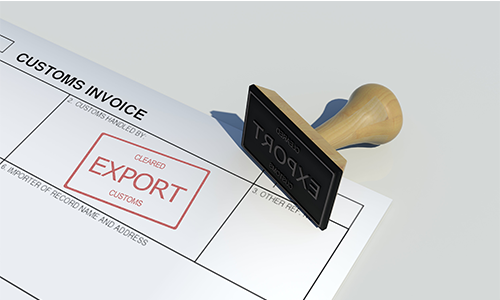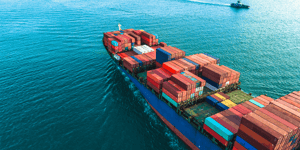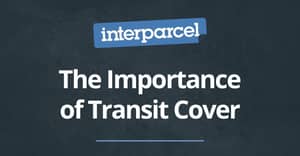If you're not familiar with commercial invoices or perhaps you'd like a refresh on how to fill one in correctly, you've come to the right place!
If you're shipping a parcel internationally, you must complete a customs invoice. The information entered will be used to generate a commercial invoice that you will need to print off and attach to your package.
Our updated 2022 guide on how to complete a commercial invoice aims to unshroud the mystery surrounding customs forms and take you through each section so you'll be a pro in no time!
What is a commercial invoice?

A commercial invoice (also known as a customs invoice) is an essential document you must fill in for all international deliveries. Every shipment leaving the UK must include an accompanying customs invoice. The document includes information such as a description of the goods being transported, the country of manufacture and HS codes and is used by customs authorities to calculate any local duties and taxes due.
How do I complete a customs invoice?
We've made filling in essential documentation as easy as possible by incorporating the customs invoice in the booking process.
When you select a parcel delivery service to the EU or the rest of the world, you'll be presented with a customs invoice section to fill in. Here, we will take you through each section of the customs invoice:
Tax Status
Choosing a Tax Status is pretty straightforward because it's based on your circumstances. You have a choice of 3 options:
Private Individual:
You are a non-business shipper and the goods you're sending are for private (non-commercial) use
Company- Not VAT Registered:
You are a non-VAT registered company (meaning your total taxable turnover for the last year was under £85,000) and the goods you're sending are for commercial use
Company- VAT Registered:
You are a VAT-registered business (meaning your total taxable turnover for the last year was over £85,000) and the goods you're sending are for commercial use. You will then be asked to enter your nine-digit VAT number issued by HMRC.
Reason for Export
The purpose of export is essential on your commercial invoice because it affects how much tax can be applied to your consignment. Below is a description of each available reason:
 Gift:
Gift:Any item sent by one private individual to another private individual. It's helpful to add 'gift' into your item description for further clarity
Sale:Goods that have been sold
Sample:Items that are not suitable for sale and are sent to secure a future order/potential customer
Repair:This describes goods that are being sent for repair, or repaired items that are being shipped back to the buyer
Return:Goods that have previously been sent and are now being returned to its original destination
Documents:Any parcel that contains documents or paperwork
Personal Effects:Any shipment containing personal items, such as luggage, that individuals will have delivered when moving house
IOSS Number - for EU deliveries
If you are a UK business and the purpose of export is a Sale, you can enter your IOSS number on the customs Invoice.
The Import One-Stop Shop (IOSS) is available for Business-to-Consumer (B2C) shipments worth €150 (£135) or less. With the EU's VAT requirements taken care of at the point of sale, it saves time and hassle as your business will pay any VAT due in one monthly payment.
UK Businesses are not required to sign up to IOSS but it does have many benefits if you regularly send to EU buyers.
EORI Number
An Economic Operator Registration and Identification (EORI) number is used by Customs to identify the company that is exporting or importing goods to European Union. It is mandatory for both VAT and non-VAT registered businesses. Otherwise, you won't be able to trade goods from the UK to the EU. You do not need an EORI number if you only send goods for personal use.
For UK businesses, EORI numbers start with 'GB' and contain 12 digits. You must enter this number in the 'Sender's EORI number' box.
If you are a trader outside of the EU sending to a business address in the EU, you are required to provide the recipient's EORI number in the 'Receiver's EORI number' section on the customs invoice. We strongly recommend you enter the Receiver's EORI number regardless as it helps speed up the customs process.
If you move goods between Northern Ireland and the Republic of Ireland, you won't have an EORI number. However, if you trade between Northern Ireland and the UK, you will need an EORI number.
Parcel Contents
You must enter the details of each item in your parcel(s). Customs require a concise and informative description of your goods so they can accurately verify what you are shipping matches the items listed on your invoice. False or inaccurate product descriptions can lead to delays or confiscation, so don't be caught out when your parcel is scanned and X-rayed. Equally, if your item is found to be prohibited or restricted, it will not be allowed to pass through.

Item Description & Quantity:
- Make sure you itemise your goods with separate descriptions
- Incorrect (vague) description: Shoes
- Correct (detailed) description: A pair of ladies' size 4 suede boots
Quantity
Simply input how many units you are sending of each item
HS Code
Harmonised System Codes, also called Tariff codes, are international product naming numbers that identify the type of item you're sending. Whether you're a private individual or a business, if you're sending goods from the UK to another country, you must apply an HS code. The code is necessary for Customs to check if the item is safe to be imported/exported and apply any relevant duties.
Our HS Code Lookup Tool gives you the option to either Quick Select from a range of popular categories like 'Shoes, Clothes & Accessories' and 'Furniture' or search for your code by entering a product description.
Country of manufacture
Knowing where your item was made is important because it determines its economic nationality and duties. Typically, if an item is made up of multiple parts where more than one country was involved in the manufacture of the good, the manufacture origin is determined by the 'last substantial transformation' origin, i.e., where the good underwent a fundamental change in form, appearance or character which adds to its value.
For instance, an item such as a laptop might contain many components made in different countries and then shipped to the UK to be assembled into the final product. In this case, the country of manufacture would be the UK because that's where it underwent the most significant transformation.
Value
The value of your item determines how much duties or taxes are applied. You must provide the value of each item individually. Three factors can determine the value:
- Commercial/retail value: the price the end buyer would pay for the item (B2C sales)
- Wholesale value: the price for a single item that was purchased in bulk
- Cost price: how much it costs to make the item
Ensure you declare your item value correctly on your commercial invoices to avoid delays. If you're found to have underdeclared the value of your goods, you could be issued a surcharge. If Customs require more information, they may hold your consignment and ask the buyer to provide proof of sale
Finalise the booking and print off the commercial Invoice
Once you have filled in the customs invoice and you have completed your booking, you will need to print out 3 copies of your form and sign the declaration. Attach two copies to the outside of your parcel (one for the country you're exporting from, one for the destination country), a waterproof plastic wallet and an extra copy inside the package for the recipient.
And there you have it! Filling out a customs form might seem a little daunting but if you follow these steps and take some time to understand each section, you'll glide through Customs and be a pro at shipping a parcel to Europe and worldwide. Get an instant courier quote for your international delivery today!
If you're still a bit unsure and need some help, don't hesitate to contact our parcel experts via phone, email or live chat.










 Facebook
Facebook Twitter
Twitter Instagram
Instagram Linked In
Linked In YouTube
YouTube